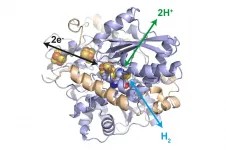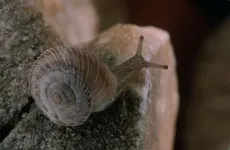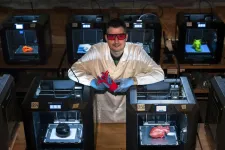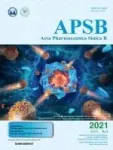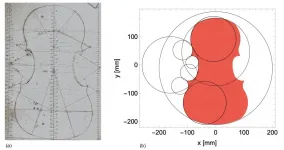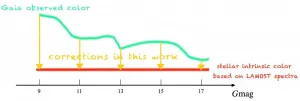Efficiently smuggling drugs into cells
2021-05-12
(Press-News.org) Modern vaccines such as those against Sars-CoV-2 use tiny lipid spheres to transport genetic information into cells and let the body build up an immune defense against the virus. A team of scientists from Erlangen, Dresden, and London has now developed a completely new method to very efficiently deliver not only genes but also drugs and other substances into cells. The researchers from the Max-Planck-Zentrum für Physik und Medizin (MPZPM) in Erlangen, the Technical University of Dresden, and The Institute of Cancer Research in London have named the method Progressive Mechanoporation and have now published it in the scientific journal "Lab on a Chip". They have also filed a patent.
Ruchi Goswami and Alena Uvizl were part of a team of scientists led by Salvatore Girardo (Erlangen) and Jörg Mansfeld (Dresden/London) who have developed the Progressive Mechanoporation. They have built a special polymer biochip that contains a series of microchannels. Each microchannel is narrower than the previous one, finally reaching a size more than ten times thinner than a human hair. The scientists pass the cells through these channels, causing the cells to stretch more and more. The stretching creates pores in their cell membrane, allowing molecules to pass through these pores and get inside the cells. Once the cells have passed through the channels, the pores close again. The scientists demonstrated that Progressive Mechanoporation can deliver even very large proteins inside the cells. As a proof of concept the scientists used antibodies and CRISPR/Cas9, the genetic scissors whose discovery led to a last year's Nobel Prize.
Potentially a new routine procedure for hospitals
"The big advantage of our method is that we can pass up to 10,000 cells per second through the chip," explains Salvatore Girardo, leader of the technology development and service group Lab-on-a-Chip at the MPZPM. At the same time, the method is very gentle. Compared to other techniques, very few cells get damaged.
The Progressive Mechanoporation method could be used in drug development and allow pharmaceutical companies to efficiently test new molecule candidates. In addition, the process can be easily automated. Jörg Mansfeld, a research group leader at the Biotechnology Center (BIOTEC) of TU Dresden and at The Institute of Cancer Research, London, adds: "I can envision that in the future, hospitals will be able to routinely examine and even treat patients' cells using Progressive Mechanoporation."
INFORMATION:
Publication:
Alena Uvizl, Ruchi Goswami, Shanil Durgeshkumar Gandhi, Martina Augsburg, Frank Buchholz, Jochen Guck, Jörg Mansfeld and Salvatore Girardo: Efficient and gentle delivery of molecules into cells with different elasticity via progressive mechanoporation. Lab on a Chip (May 2021)
doi: https://doi.org/10.1039/D0LC01224F
Media inquiries:
Max-Planck-Zentrum für Physik und Medizin
Lothar Kuhn
Tel: +49 9131 7133-825
E-mail: presse@mpzpm.de
Center for Molecular and Cellular Bioengineering, TU Dresden
Dr. Magdalena Gonciarz
Tel.: +49 351 458-82065
Email: cmcb_press@tu-dresden.de
About the Max-Planck-Zentrum für Physik und Medizin (MPZPM)
The Max-Planck-Zentrum für Physik und Medizin is conceived as a joint effort between the Max Planck Institute for the Science of Light (MPL), the Friedrich Alexander University (FAU) and the FAU University Hospital in Erlangen. The new scientific center aims to apply advanced methods from experimental physics and mathematics to basic biomedical research with an emphasis on the intercellular microenvironment
http://www.mpzpm.de
About the Biotechnology Center (BIOTEC)
The Biotechnology Center (BIOTEC) was founded in 2000 as a central scientific unit of the TU Dresden with the goal of combining modern approaches in molecular and cell biology with the traditionally strong engineering in Dresden. Since 2016, the BIOTEC is part of the central scientific unit "Center for Molecular and Cellular Bioengineering" (CMCB) of the TU Dresden. The BIOTEC is fostering developments in research and teaching within the Molecular Bioengineering research field and combines approaches in cell biology, biophysics and bioinformatics. It plays a central role within the research priority area Health Sciences, Biomedicine and Bioengineering of the TU Dresden.
http://www.tu-dresden.de/cmcb/biotec
http://www.tu-dresden.de/cmcb
About The Institute of Cancer Research, London
The Institute of Cancer Research, London, is one of the world's most influential cancer research organisations.
Scientists and clinicians at The Institute of Cancer Research (ICR) are working every day to make a real impact on cancer patients' lives. Through its unique partnership with The Royal Marsden NHS Foundation Trust and 'bench-to-bedside' approach, the ICR is able to create and deliver results in a way that other institutions cannot. Together the two organisations are rated in the top four centres for cancer research and treatment globally.
The ICR has an outstanding record of achievement dating back more than 100 years. It provided the first convincing evidence that DNA damage is the basic cause of cancer, laying the foundation for the now universally accepted idea that cancer is a genetic disease. Today it is a world leader at identifying cancer-related genes and discovering new targeted drugs for personalised cancer treatment.
A college of the University of London, the ICR is the UK's top-ranked academic institution for research quality, and provides postgraduate higher education of international distinction. It has charitable status and relies on support from partner organisations, charities and the general public.
The ICR's mission is to make the discoveries that defeat cancer.
For more information visit ICR.ac.uk
[Attachments] See images for this press release:

ELSE PRESS RELEASES FROM THIS DATE:
2021-05-12
An enzyme could make a dream come true for the energy industry: It can efficiently produce hydrogen using electricity and can also generate electricity from hydrogen. The enzyme is protected by embedding it in a polymer. An international research team with significant participation of scientists from Technical University of Munich (TUM) has presented the system in the renowned science journal Nature Catalysis.
Fuel cells turn hydrogen into electricity, while electrolysers use electricity to split water to produce hydrogen. Both need the rare and thus expensive precious metal platinum as a catalyst. Nature has created a different solution: Enzymes, referred to as hydrogenases. ...
2021-05-12
Experts in virtual reality locomotion have developed a new resource that analyses all the different possibilities of locomotion currently available.
Moving around in a virtual reality world can be very different to walking or employing a vehicle in the real world and new approaches and techniques are continually being developed to meet the challenges of different applications.
Called Locomotion Vault, the project was developed by researchers at the Universities of Birmingham, Copenhagen, and Microsoft Research. It aims to provide a central, freely-available ...
2021-05-12
A study published in the journal Scientific Reports reveals the genetic structure of the land snail Xerocrassa montserratensis and it provides new scientific tools for the improvement of the conservation of this endemic and threatened species in Catalonia. This land mollusc, identified in the late 19th century in the Montserrat mountain, has a reduced geographical distribution limited to the province of Barcelona, and it is a protected species in the area of the natural parks of Montserrat and Sant Llorenç del Munt i l'Obac.
The study is led by the lecturer Marta Pascual, from the Faculty of Biology and the Biodiversity Research Institute of the University of Barcelona ...
2021-05-12
Skeletal muscles make a tremendous variety of actions stabilizing the body in different positions. Despite their endurance during daily activities, they can undergo several mild injuries caused by sport, accidental overstretching, or sudden overtwisting. Luckily mild injuries can be quickly healed; however, when a large part of muscles is damaged or resected surgically, the full recovery can be impossible. Muscle regeneration is challenging, but the development of innovative biocompatible materials tackles that problem. Recently, a multinational team of scientists led by dr. Marco Costantini from ...
2021-05-12
Acta Pharmaceutica Sinica B Volume 11, Issue 4 Publishes
https://www.sciencedirect.com/journal/acta-pharmaceutica-sinica-b/vol/11/issue/4
Special Issue: The Biological Fate of Drug Nanocarriers
This special issue includes seven review and nine research articles from some leading scientists in the field that further the discussion on subtopics of in vivo fate of drug nanocarriers.
Guest Editors: Wei Wu, Professor, Department of Pharmaceutics, School of Pharmacy, Fudan University, Shanghai, China; Tonglei Li, Professor, Department of Industrial & Physical Pharmacy, Purdue University, West Lafayette, IN, USA; Ying Zheng, Professor, State Key Laboratory of Quality Research in Chinese Medicine, Institute of Chinese Medical Sciences, University of Macau, Macau, China.
The Journal ...
2021-05-12
How to predict the sound produced by a tonewood block once carved into the shape of a violin plate? What is the best shape for the best sound? Artificial Intelligence offer answers to these questions.
These are the conclusions that researchers of the Musical Acoustics Lab of Politecnico di Milano presented in a study that was recently published in Scientific Reports.
In the article "A Data-Driven Approach to Violinmaking" the Chilean physicist and luthier Sebastian Gonzalez (post-doc researcher) and the professional mandolin player Davide Salvi (PhD student) show how a simple and effective neural network is able to predict the vibrational be-havior of violin plates. This prediction is obtained from a limited set of geometric and mechanical ...
2021-05-12
The Large Sky Area Multi-Object Fiber Spectroscopic Telescope (LAMOST) has helped Gaia achieve millimagnitude (mmag) precision in photometry, according to a study led by researchers from National Astronomical Observatories of Chinese Academy of Sciences (NAOC) and Beijing Normal University (BNU).
Their study was published in The Astrophysical Journal.
If you look at the sky on a clear, starry night, you may notice that Aldebran is relatively red and Rigel is blue. Why? The answer stems from their intrinsic physical properties. Precisely measuring magnitudes ...
2021-05-12
The polar vortex is a large area of upper-atmosphere cyclonic air circulation surrounding both poles. It is bounded by the polar jet stream and its associated cold air is usually confined to the polar regions. Within the Antarctic circle, and southern polar vortex, ozone quantities are the lowest, globally. A research published in Advances in Atmospheric Sciences, led by Dr. LUO Yuhan, corresponding author and Associate Professor at the Hefei Institutes of Physical Science (HFIPS), suggests that the polar vortex plays a key role in Antarctic stratospheric ozone depletion.
"The atmosphere over Antarctica is controlled by a strong ...
2021-05-12
May 1, 2021 - Rheumatologists in Hong Kong joined hands to develop a set of consensus statements on COVID-19 vaccination for local adult patients with autoimmune rheumatic diseases. These timely statements would serve to be a guide for rheumatologists, other specialists, family physicians, specialty nurses, and the public regarding COVID-19 vaccination for patients with rheumatic diseases.
Vaccination against SAR-CoV-2 is a new campaign and a high immunization rate is believed to be the key to end the pandemic. Currently, there are two COVID-19 vaccines available in Hong Kong--the inactivated virus vaccine CoronaVac® ...
2021-05-12
Parks played an important role for people seeking respite from the toll of social isolation during the pandemic, and according to new research from Drexel University, they did so without increasing the spread of COVID-19. The study looked at how people used 22 parks in Philadelphia and New York during the height of the pandemic and it found no strong correlation between park use and the number of confirmed cases in surrounding neighborhoods.
Published in the Journal of Extreme Events, Drexel's study "Urban Park Usage During the COVID-19 Pandemic" surveyed park visitors over a three-month period from May to July 2020 at small and mid-size parks in New York and Philadelphia. And it compared park usage numbers ...
LAST 30 PRESS RELEASES:
[Press-News.org] Efficiently smuggling drugs into cells

